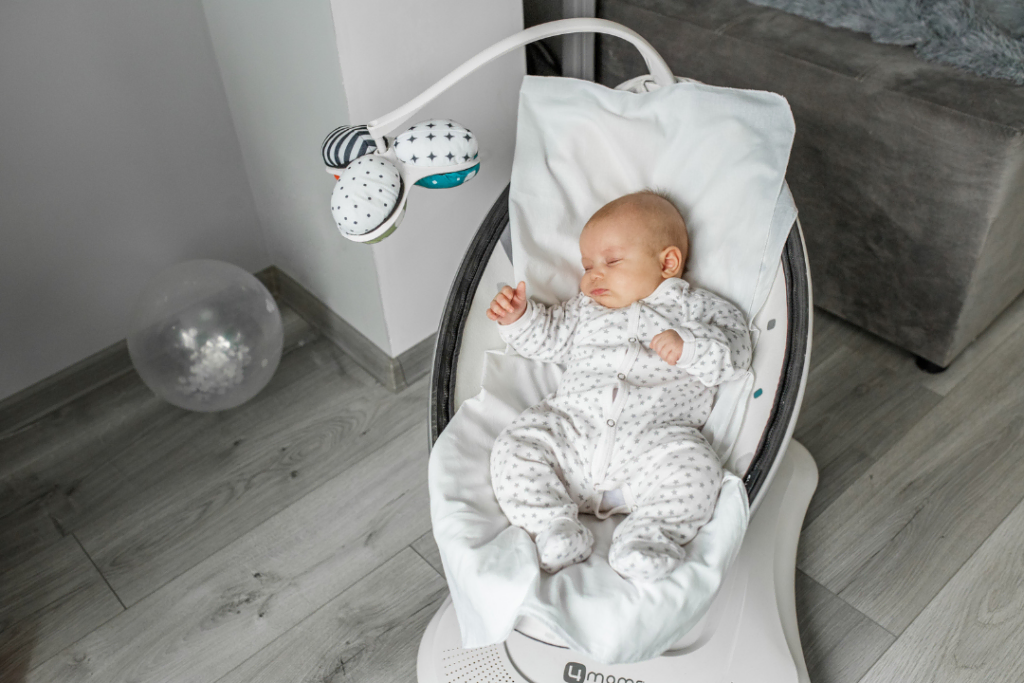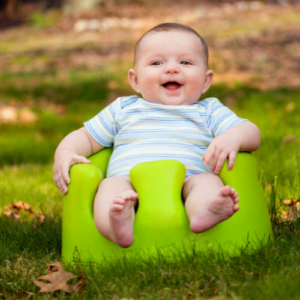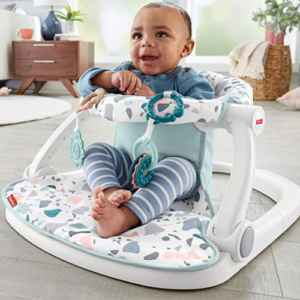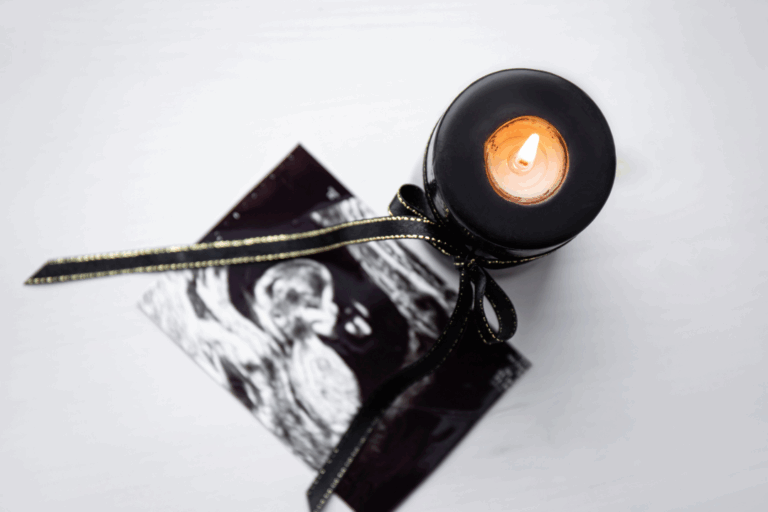Are baby seats bad for development? It’s a controversial topic that can confuse and worry parents who don’t have the right information. The short answer is that, yes, baby seats are bad for your baby’s development but let’s look deeper at the subject so you can make a conscious choice when deciding to use baby seats.
How can a baby seat impact a babies development?
When we talk about baby seats, it includes bouncers, swings, high chairs, car seats and other seating devices, such as Bumbo seats (more on this later). For many parents, baby seats are a convenient way to keep baby contained or to soothe fussy infants. There’s nothing wrong with using these tools provided that they are a safe and secure place for babies to rest and play. But the prolonged use of baby seats can have negative effects on a child’s development – and that’s what you need to be mindful of.
One concern is that baby seats can limit a child’s movement and opportunities to explore. This can get in the way of the development of gross motor skills. Babies need the chance to move and investigate their environment in order to develop the strength and coordination needed to crawl, walk, and run. When babies spend too much time in baby seats, they may not have as many opportunities to practice these skills, which can delay their development.
Another concern is that baby seats can limit a child’s social interaction and language development. Babies learn language and social skills by interacting with people and observing the world around them. When babies spend too much time in baby seats, they may miss out on these important interactions and experiences, which can delay their development in these areas.
When can a baby start sitting in a baby seat?
Babies can start sitting in a baby seat when they have developed enough head and neck control to sit up on their own, which typically happens around 4-6 months of age. Before this age, babies may need to be supported in a reclined position, such as in a car seat or a bouncer, to avoid straining their developing neck muscles.
It’s also worth noting that while baby seats can be helpful for keeping your baby secure and freeing up your hands to do other things, baby seats should not be used as a substitute for adult supervision or interaction. Babies need plenty of opportunities to explore and move their bodies freely, so it’s important to balance time spent in baby seats with time spent on the floor, in a playpen, or in your arms.
How to choose the right baby seat
When choosing a baby seat, it is important to make sure it is appropriate for your baby’s age and size, and that it meets safety standards. Be sure to follow the manufacturer’s instructions for installation and use, and always supervise your baby when they are in the seat. Here are some tips to help you choose the right baby seat:
Consider your child’s age and weight
Baby seats are typically designed for specific age ranges and weight limits. Make sure you choose a seat that is appropriate for your child’s size and age. For example, an infant car seat is suitable for newborns and young infants, while a convertible car seat can be used from birth up to toddlerhood.
Choose a baby seat that fits your vehicle
Some baby seats may be better suited to certain types of vehicles, so check the manufacturer’s specifications to ensure that the seat will fit in your car. You can also consult with a certified Child Passenger Safety Technician for guidance.
Look for safety features
Make sure the baby seat you choose meets safety standards and has features such as a five-point harness, side-impact protection, and easy-to-use buckles and straps. This applies to high chairs, baby bouncers as well as car seats.
Consider your lifestyle
If you are an active family that spends a lot of time outdoors, you may want a baby seat that is easy to transport, such as a lightweight stroller or a baby carrier. If you frequently travel by car, you may want a baby seat that is easy to install and adjust, such as a car seat with a base that stays in the car.
Read reviews and do your research
Look for reviews and ratings from other parents to get a sense of how well a particular baby seat performs in real-world situations. You can also consult with a healthcare professional or a certified Child Passenger Safety Technician for guidance and recommendations.
Remember, the most important factor when choosing a baby seat is safety, so always follow the manufacturer’s instructions and use the seat properly to ensure your baby’s safety and well-being.
The difference between a Bumbo baby seat vs Sit-Me-Up baby seat
Both the Bumbo and Sit-Me-Up baby seats are designed to allow babies to sit up independently. I have to admit that I am not a fan of Bumbo seats in particular. They don’t support your baby in the right way to allow them to build the strength they need to sit unassisted. They can also be dangerous because should the seat topple over, your baby will go with it and won’t be able to free themselves. My advice is to avoid these sort of seats as much as possible but if you do need to use them, never place them on a counter top, table or high surface or leave your baby unattended.
Sit-Me-Up seats are a better alternative but still no match for the simple methods of encouraging your baby’s development that we’ll discuss below.
Bumbo Seat
Sit-Me-Up chair (Photo source: Amazon)
When considering these two options, it’s important to note some key differences between the two:
Design: The Bumbo baby seat is a single molded seat made of foam, with a wide base and a low backrest. The Sit-Me-Up baby seat is designed so your baby can sit on the floor on a fabric seat that is suspended by a frame, and a tray for toys or snacks.
Age range: The Bumbo baby seat is said to be suitable for infants aged 4 to 12 months, or until they can sit up unassisted. The Sit-Me-Up baby seat is suitable for infants aged 6 to 12 months, or until they can crawl out of the seat.
Support: The Bumbo baby seat provides support for the baby’s back and hips, to allow them to maintain an upright position. The Sit-Me-Up baby seat also provides support for the baby’s back, but it allows them to lean forward and reach for toys on the tray.
Portability: The Bumbo baby seat is lightweight and easy to move around. The Sit-Me-Up baby seat is larger and more bulky, and may be less portable.
Safety: Both the Bumbo baby seat and the Sit Me Up baby seat should be used with caution and under supervision. Also bear in mind that they are not designed for use as a safety restraint.
Alternatives to baby seats for supporting a child’s development
While baby seats can be a helpful tool there are much more effective ways of boosting your baby’s development:
Tummy time
Tummy time is an important activity for babies to help develop their neck, back, and shoulder muscles. Placing your baby on their stomach on a soft, flat surface for short periods of time each day can help strengthen these muscles and prepare them for crawling and other developmental milestones.
Baby wearing
I’m a huge advocate of baby wearing. Carrying your baby in a baby carrier can help provide them with the closeness and support they need while allowing them to explore the world around them. Baby wearing can also promote bonding between you and your baby.
Floor play
Allowing your baby to play on a soft, flat surface such as a playmat or blanket can help them develop their gross motor skills, such as rolling, reaching, and crawling. Providing them with toys and other objects to explore can also help develop their fine motor skills.
Bouncer or swing
Bouncers or swings can provide a safe and comfortable place for your baby to rest and play. Most come with toys attached or a mobile to keep your baby engrossed. Even though your baby should be strapped in using all the available safety harnesses, these seats allow your baby to move and wiggle while still providing support for their developing muscles.
High chair
Once your baby is old enough to start eating solid foods, a high chair can provide a safe and supportive place for them to sit and explore new foods. It’s also a great way to include your baby in the social and emotional aspect of eating together.
That leaves one more question that we need to discuss…
What to avoid when using baby seats?
- Try not to let your baby sleep in their baby seat. It’s not always practical when in the car or out and about in the stroller but when you are home, try to place your baby in their sleep space for naps.
- Bear in mind that your baby can become accustomed to being rocked to sleep after about 6 months and it’s a hard habit to break. If you are soothing your baby in a bouncer – use it mindfully and not as a go-to to calm your baby. Try baby wearing instead.
- Never leave your baby alone in a baby seat. Never.
- Always ensure that you are using the baby seat correctly and safely!
Remember, play time on the floor is best! If you’re struggling to come up with play ideas for your baby, download my Parent Sense app. You’ll get an activity to do with your baby to optimise their development for everyday of their first year.






